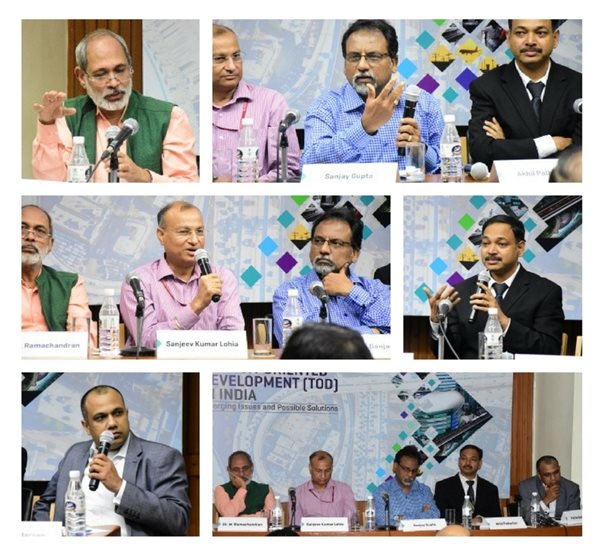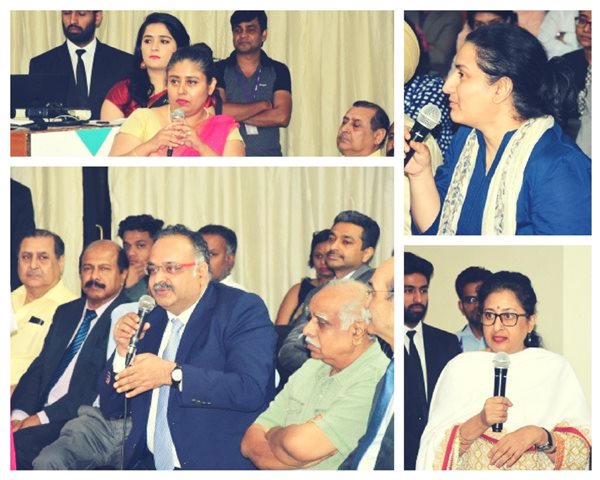_8.jpg?ext=.jpg)
The panel discussion was organized on 26th April 2018, at the India International Centre, New Delhi to bring out a suggestive roadmap for effective implementation of TOD policies, inter alia, to develop a better understanding of TOD, ensure success of projects and to provide industry inputs to policymakers. It was heartening to see the large turnout at the event and the active participation by a varied mix of professionals in the audience that included lawyers, researchers, urban planners, architects, social researchers, academicians to name a few. Importantly, it was reassuring to see some of our alumni attending the event.
Understanding the significance of interdisciplinary learning for knowledge creation, the panelists exclusively were experts from various professional domains. It was a thorough learning process to hear and brainstorm with minds that were instrumental in conceptualizing the Transit oriented development model for India and are also presently involved in executing projects on grounds. The panel comprised of Dr. M. Ramachandran, former Secretary Ministry of Urban Development, identified as the “Infrastructure Man” in the state of Uttaranchal. Dr. Sanjay Gupta, the Head of the Department, Transport Planning, School of Planning and Architecture, Delhi, Mr. Akhil Palherkar, Joint General Manager, Larsen and Toubro, Mr. Sanjeev Kumar Lohia, MD &CEO Indian Railway Stations Development Corporation (IRSDC), Mr. Vishnu Sudarsan, lawyer, Partner at J. Sagar Associates Law Firm and Mr. Vinay Kapoor, CEO, West Court Real Estate Private Limited, who joined us over Skype.
The esteemed panel collectively concluded that transit is the central element and must precede development. The phenomenal intellectual capacities of the panelists resulted in finding answers for some pertinent questions around TOD implementation in India.

Discussion summary
Dr. M. Ramachandran, former Secretary, Ministry of Urban Development, identified as the “Infrastructure Man” in the state of Uttaranchal, made his valuable contributions in highlighting the significance of and issues around policy making and integration. It was argued, capacity of urban local bodies and public participation remain key ingredients, hence strengthening urban governance, empowering city authorities and establishment of Urban Metropolitan Transport Authority to coordinate among different transit policies can significantly enhance TOD implementation.
To complement, Dr. Sanjay Gupta, the Head of the Department, Transport Planning, School of Planning and Architecture, Delhi brought out the need to integrate urban planning processes with the TOD model. When on one hand our panelist, Mr. Akhil Palherkar, Joint General Manager, Larsen and Toubro, underlined the procedural and bureaucratic impediments to implementation of TOD, by sharing his experiences while overseeing the Seawoods Grand Central, Navi Mumbai one of the largest integrated Transit Oriented Development project in India; Mr. Sanjeev Kumar Lohia, MD &CEO Indian Railway Stations Development Corporation (IRSDC),strongly opined and suggested valuable way forward to negate governance bottlenecks, just as the RLDA is successfully doing in some of its projects across India.
Thereby, the need for strengthen public private partnerships through clearly defined roles and responsibilities was reiterated. To add to the discussion, Mr. Vishnu Sudarsan, lawyer, Partner at J Sagar Associates Law Firm, reassured the possibilities in being able to remove regulatory barriers for efficient implementation of TOD projects in India alongside use of innovative financial mechanisms and allowing foreign investment. To learn from international practices, Mr. Vinay Kapoor, CEO, West Court Real Estate Private Limited, joined us over Skype. He threw light on his learning from the Canary Wharf, London TOD project.

Key questions addressed
- What are the challenges in implementation of TOD projects? How to effectively address them?
- How to provide enough (financial) resources for TOD projects?
- How to assure creation of sustainable and affordable infrastructure in TOD projects?
- How to embody TOD in the Master Plan? Going beyond mere integration of land use and transportation planning, which other aspects of planning would be crucial for effective implementation?
- What should be the institutional mechanisms and governance structures?
Way forward
Considering the phenomenal response received, the School is deliberating to organize another dialogue on a similar theme to take this forward.